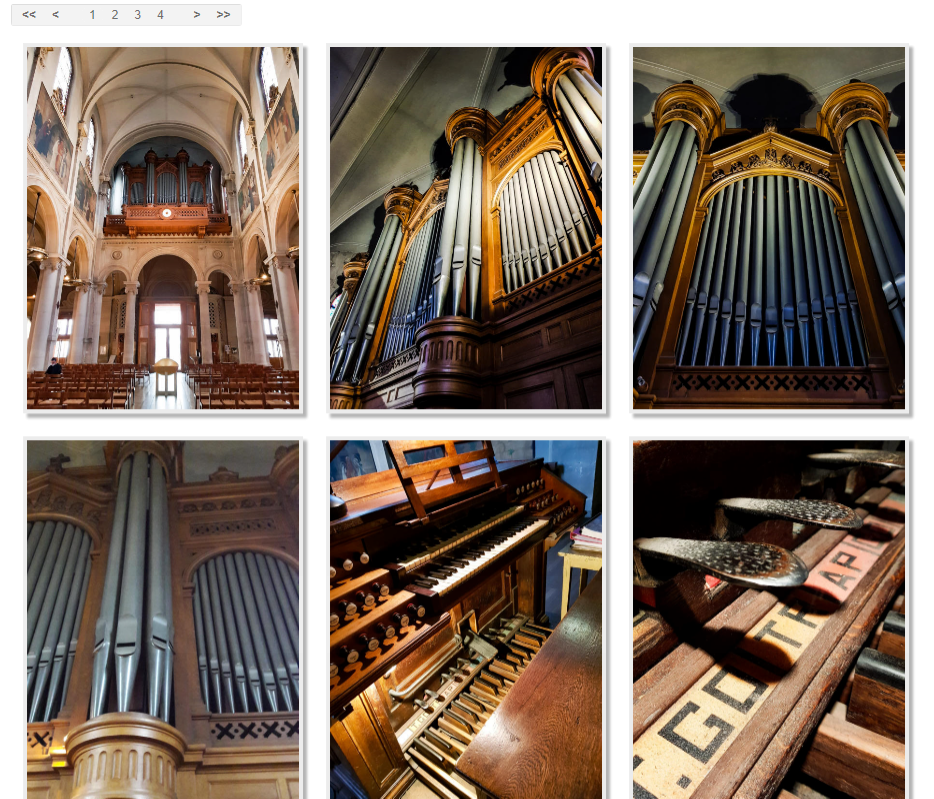


ORGANS OF PARIS © 2024 Vincent Hildebrandt HOME ALL ORGANS



Organiste titulaire
Yannick Merlin & Philippe Ourselin
Famous organists in the past:
René Vierne, Jean-Pierre Leguay
Concerts
Irregularly
Masses with organ
Saturday 6.30p.m., Sunday 11p.m., 5.30p.m., 7.30p.m.
Videos
Yannick Merlin
Olivier ALAIN –
Suite pour Rameau pour trompette et orgue (1964)
François Frémeau (trompette), Yannick Merlin (orgue)
Ouverture - Sarabande - Loure vive - Contredanse -
Air italien - Rigaudon - Menuet grave - Tambourins
Philippe Ourselin - J. Brahms Praelidum und fuge in A
C2
The organ of Notre-Dame-des-Champs was built by
Cavaillé-Coll in 1877. It originally consisted of 26 stops.
1947
Daniellot & Salmon carried out maintenance works. On
this occasion, the organ was set back by 1.80 m.
1973
Schwenkedel altered the instrument, replacing the
Plein Jeu progressif of the GO by a Fourniture V and
Cymbale IV and adding a Plein Jeu IV on the récit. He
added a Doublette, Flûte à fuseau, Sesquialtera and a
Tierce on the récit (out of the old Plein Jeu) and on the
récit he replaced the Flûte traversière by a Bourdon 8,
the Flûte octaviante 4 by a Principal italien 4 et the old
Octavin by a Flûte 2. The pedal was enlarged with the
addition of a new wind chest of 8 stops, with 4 new
stops added. The organ was re-harmonized by Laurent
Steinmetz.
2004
Overhaul by Yves Fossaert

The origin of the place of Notre-Dame-des-Champs dates
back to the early days of Christianity, the temple was
dedicated to the Virgin and took the name of Our Lady of
the Vignes. King Robert the Pious (972-1031) decided to
rebuild the building and entrust it to Benedictine monks
from the Alsatian abbey of Marmoutier. In the 18th
century, the abbey enjoyed a prodigious influence.
Bossuet preached there. Mademoiselle de la Vallière
withdrew there. Madame Acarie (beatified in 1791)
assisted Cardinal de Bérulle in his Carmelitan reform.
During the Revolution, the convent was closed, the
church destroyed. In 1858, the parish was created. In
1867, the architect Paul-René-Léon Ginain (1825-1898)
began the construction of the present church, freely
inspired by the Romanesque style. It was completed in
1876. Charles Mutin was a parishioner of this church
located not far from the former Cavaillé-Coll workshops.

1877 - Cavaillé-Coll (1)
1947 - Daniellot et Salmon (6)
1973 - Schwenkedel (3a)
2004 - Fossaert (6)
II/34 -
composition

Organs of Paris
ORGANS OF PARIS © 2024 Vincent Hildebrandt ALL ORGANS
C2
The organ of Notre-Dame-des-Champs was built by Cavaillé-
Coll in 1877. It originally consisted of 26 stops.
1947
Daniellot & Salmon carried out maintenance works. On this
occasion, the organ was set back by 1.80 m.
1973
Schwenkedel altered the instrument, replacing the Plein Jeu
progressif of the GO by a Fourniture V and Cymbale IV and
adding a Plein Jeu IV on the récit. He added a Doublette,
Flûte à fuseau, Sesquialtera and a Tierce on the récit (out of
the old Plein Jeu) and on the récit he replaced the Flûte
traversière by a Bourdon 8, the Flûte octaviante 4 by a
Principal italien 4 et the old Octavin by a Flûte 2. The pedal
was enlarged with the addition of a new wind chest of 8
stops, with 4 new stops added. The organ was re-
harmonized by Laurent Steinmetz.
2004
Overhaul by Yves Fossaert
Organiste titulaire
Yannick Merlin & Philippe Ourselin
Famous organists in the past:
René Vierne, Jean-Pierre Leguay
Concerts
Irregularly
Masses with organ
Saturday 6.30p.m., Sunday 11p.m., 5.30p.m., 7.30p.m.
Videos
Yannick Merlin
Olivier ALAIN –
Suite pour Rameau pour trompette et orgue (1964)
François Frémeau (trompette), Yannick Merlin (orgue)
Ouverture - Sarabande - Loure vive - Contredanse -
Air italien - Rigaudon - Menuet grave - Tambourins
Philippe Ourselin - J. Brahms Praelidum und fuge in A

1877 - Cavaillé-Coll (1)
1947 - Daniellot et Salmon (6)
1973 - Schwenkedel (3a)
2004 - Fossaert (6)
II/34 -
composition






















